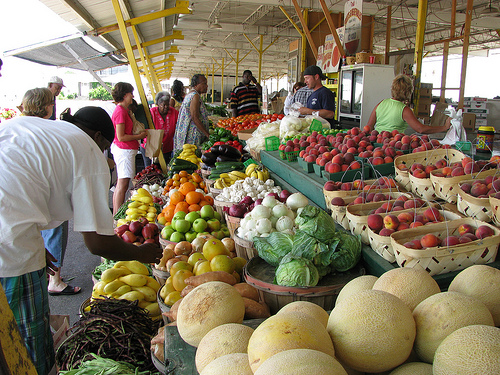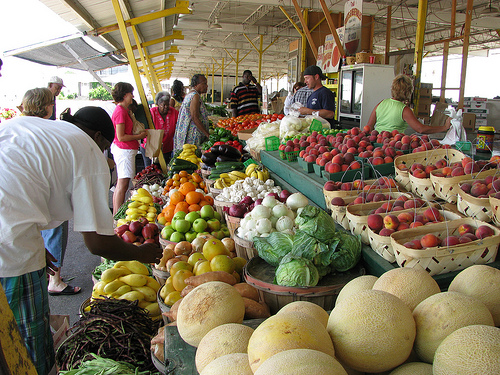 Photo: Natalie MaynorEarlier this week, the Wall Street Journal aired a bit of dirty laundry that was hiding out in local food’s hamper — the ongoing fight over who gets to sell in farmers markets. Many markets require that sellers be actual growers, rather than “resellers” of some form or another. At a certain level, this makes perfect sense: despite the dropped apostrophe, they’re not called farmers markets for nothing. And once you open the door to resellers, you also open the door to things like “farmwashing” — sellers falsely claiming they grew their wares — or even California produce beating out locally grown products at, say, a Wisconsin farmers market.
Photo: Natalie MaynorEarlier this week, the Wall Street Journal aired a bit of dirty laundry that was hiding out in local food’s hamper — the ongoing fight over who gets to sell in farmers markets. Many markets require that sellers be actual growers, rather than “resellers” of some form or another. At a certain level, this makes perfect sense: despite the dropped apostrophe, they’re not called farmers markets for nothing. And once you open the door to resellers, you also open the door to things like “farmwashing” — sellers falsely claiming they grew their wares — or even California produce beating out locally grown products at, say, a Wisconsin farmers market.
Of course, the heart of the WSJ piece is a nasty fight over price, as it always seems to be with food:
Local farmer Ronald Waege, who grows his own apples and blueberries just outside of town, says resellers are buying up produce at an auction and peddling it here, sometimes undercutting his own prices. Mr. Waege, who insists he’s looking after the interests of consumers, has prodded the Tomah City Council to decide whether or not to ban resellers from the market. The council plans to vote on the issue next month.
Resellers, some of whom have been operating here for years, are furious. Ralph Wendland, a vendor who grows his apples but also resells pumpkins, made “verbal threats to bash my head in while swinging a cane in my direction,” Mr. Waege wrote in a letter to city officials in January.
Mr. Wendland says he told Mr. Waege, “if he didn’t keep his nose out of my business, I’d knock him on his a–.”
Whose business is it?
Good question. And we’d best answer it soon, because the numbers of farmers markets are exploding. Many people think that the USDA’s 5,000+ number is far under the actual total: farmers market managers should go to the USDA’s site and fill out their survey so we can know how many markets are really out there. Plus, as consumers — especially parents with young children — continue to shift their buying away from supermarkets, it’s important to remember that many farmers markets do far more than sell produce.
Direct farmer-to-consumer sales are the quickest, easiest, and cleanest way to increase farmers’ share of consumer spending. Right now that’s a mere 7 cents on the dollar. And farmers markets also represent a relatively easy way to improve access to healthy foods in low-income neighborhoods. While more and more farmers markets accept food stamps, groups like Wholesome Wave provide “coupons” that then double their buying power. Ladies and gentlemen: I give you subsidized vegetables!! And though that particular program is privately funded, there’s no reason that the USDA couldn’t in its wisdom decide to launch a similar one on its own. Farmers markets are, in a word, important.
But that doesn’t mean things can’t or shouldn’t change. Los Angeles Times writer Russ Parsons addressed what’s wrong with farmers markets in a recent article. He started with an excellent overview of the business side:
Farmers markets have increased choice and improved the quality of fruits and vegetables for shoppers, and, perhaps most radically, they have provided farmers with a way to actually earn more money by selling food with flavor, as opposed to mainstream farmers who grow primarily for volume.
But what’s even more remarkable is that farmers markets have achieved all of that despite what has to be one of the most inefficient business plans ever devised. If you wanted to design a market from scratch, this almost certainly wouldn’t be the way you’d do it. Let’s see … it’ll be open for only four hours a week. If a customer can’t make it, they miss it. Let’s just stick the markets wherever we can. And if shoppers can’t find a parking spot, they miss it. For farmers, there’s the not inconsiderable matter of having to drive hundreds of miles every day to spend hours standing outside, weighing lettuce and making change.
Parsons then goes on to wonder about how to take farmers markets to the next level — how to sidestep the very conflicts the Wall Street Journal highlighted. Instead of focusing only on keeping farmers markets safe for farmers, we should be thinking about ways to get small-scale, local farmers into more and different markets, and doing so while preserving their share of the consumer dollar.
But really, I’m just beating around the bush to avoid using the word that most accurately describes the larger issue of which farmers markets are just a part: infrastructure. Regional food systems don’t have enough of it and they can’t expand without it. In fact, the Leopold Center of Iowa State University just did a study showing that the six main Midwestern states could grow their own fruits and vegetables on a relatively small amount of land, if only there was a way to store, effectively distribute and market it.
The USDA is certainly paying attention to this issue, especially in terms of its Know Your Farmer, Know Your Food initiative (much to the consternation of agribusiness and its clients). Yet it’s crucial to remember that anything that moves the farmer farther from the consumer, such as resellers at farmers markets, may lower the retail price for consumers, but usually also takes money out of farmers’ pockets. (You don’t think the middleman shoulders the hit, do you?) There are many other ways to make fresh food available to everyone at an affordable price — farmer delivery co-ops to supply local supermarkets or year-round, staffed farmers markets, to name two — without taking it out of the hide of the people who actually grow our food.




